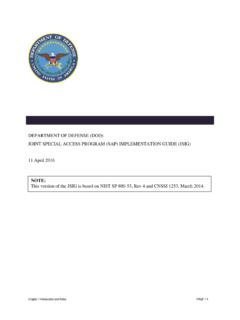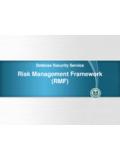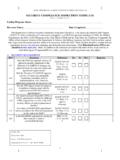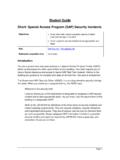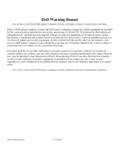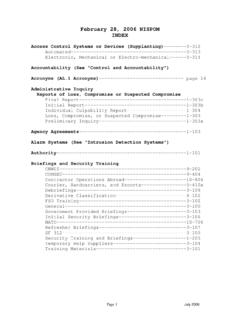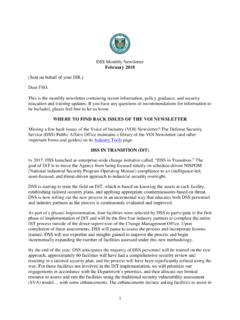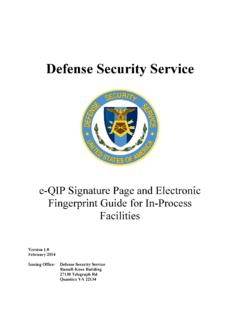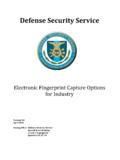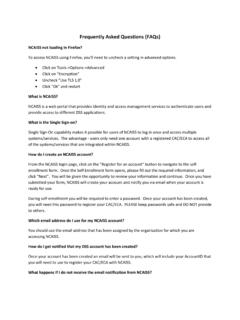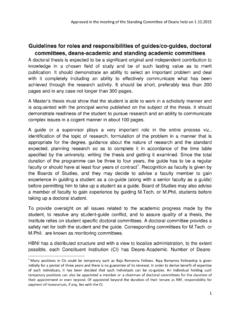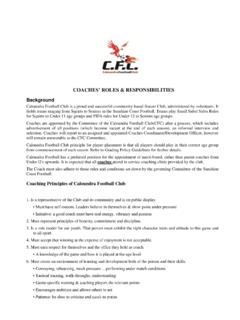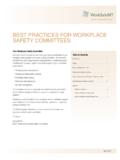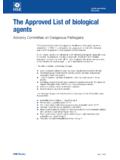Transcription of SECURITY CATEGORIZATION AND CONTROL …
1 1. CNSSI No. 1253. 27 March 2014. SECURITY CATEGORIZATION AND. CONTROL selection FOR. NATIONAL SECURITY SYSTEMS. THIS INSTRUCTION PRESCRIBES MINIMUM STANDARDS. YOUR DEPARTMENT OR AGENCY MAY REQUIRE FURTHER. IMPLEMENTATION. CNSSI No. 1253. NATIONAL MANAGER. FOREWORD. 1. The Committee on National SECURITY Systems (CNSS) Instruction No. 1253, SECURITY CATEGORIZATION and CONTROL selection for National SECURITY Systems, provides all Federal Government departments, agencies, bureaus, and offices with guidance on the first two steps of the Risk Management Framework (RMF), Categorize and Select, for national SECURITY systems (NSS). This Instruction builds on and is a companion document to National Institute of Standards and Technology (NIST) Special Publication (SP), 800-53, SECURITY and Privacy Controls for Federal Information Systems and Organizations; therefore, it is formatted to align with that document's section numbering scheme.
2 This Instruction should be used by information systems SECURITY engineers, authorizing officials, senior information SECURITY officers, and others to select and agree upon appropriate protections for an NSS. 2. The authority to issue this Instruction derives its authority from National SECURITY Directive 42, National Policy for the SECURITY of National SECURITY Telecommunications and Information Systems, which outlines the roles and responsibilities for securing NSS, consistent with applicable law, 12333, as amended, and other Presidential directives. Nothing in this Instruction shall alter or supersede the authorities of the Director of National Intelligence.
3 3. This Instruction supersedes CNSSI No. 1253 dated March 15, 2012. 4. All CNSS member organizations should plan their transition to new versions of this Instruction, including periodic updates of the SECURITY CONTROL allocations. The transition should account for new overlays that are published independently as attachments to Appendix F of this Instruction. 5. CNSSI No. 1253 appendices will be reviewed and administratively updated, as required, on a quarterly basis to reflect changes to protect NSS. 6. Additional copies of this Instruction may be obtained from the CNSS Secretariat or the CNSS. website: FOR THE NATIONAL MANAGER. /s/. DEBORA A. PLUNKETT. CNSS Secretariat (IE32).
4 National SECURITY Agency. 9800 Savage Road, STE 6716. Ft M eade, M D 20755-6716. Office: (410) 854-6805 Unclassified FAX: (410) 854-6814. i CNSSI No. 1253. TABLE OF CONTENTS. CHAPTER ONE: INTRODUCTION ..1. PURPOSE AND SCOPE ..1. DIFFERENCES BETWEEN CNSSI NO. 1253 AND NIST PUBLICATIONS ..2. CHAPTER TWO: THE FUNDAMENTALS ..3. ADOPTION OF NIST SP 800-53 AND FIPS 199 ..3. ASSUMPTIONS RELATED TO SECURITY CONTROL BASELINES ..3. RELATIONSHIP BETWEEN BASELINES AND OVERLAYS ..4. CHAPTER THREE: THE CATEGORIZE AND SELECT PROCESSES ..5. RMF STEP 1: CATEGORIZE INFORMATION SYSTEM ..5. RMF STEP 2: SELECT SECURITY CONTROLS ..6. APPENDIX A REFERENCES .. A-1. APPENDIX B GLOSSARY.
5 B-1. APPENDIX C ACRONYMS ..C-1. APPENDIX D SECURITY CONTROL TABLES .. D-1. APPENDIX E SECURITY CONTROL PARAMETER VALUES .. E-1. APPENDIX F OVERLAYS .. F-1. TABLE OF FIGURES AND TABLES. Table D-1: NSS SECURITY CONTROL Baselines .. D-1. Table D-2: Additional SECURITY CONTROL Information .. D-37. Table E-1: SECURITY CONTROL Parameter Values for NSS .. E-1. ii CNSSI No. 1253. CHAPTER ONE. INTRODUCTION. The CNSS has worked with representatives from the Civil, Defense, and Intelligence Communities, as part of the Joint Task Force Transformation Initiative Working Group (JTF) to produce a unified information SECURITY framework. As a result of this collaboration, NIST.
6 Published the following five transformational documents: NIST SP 800-30, Guide for Conducting Risk Assessments;. NIST SP 800-37, Guide for Applying the Risk Management Framework to Federal Information Systems: A SECURITY Life Cycle Approach;. NIST SP 800-39, Managing Information SECURITY Risk: Organization, Mission, and Information System View;. NIST SP 800-53, SECURITY and Privacy Controls for Federal Information Systems and Organizations; and NIST SP 800-53A, Guide for Assessing the SECURITY Controls in Federal Information Systems and Organizations: Building Effective SECURITY Assessment Plans. The intent of this common framework is to improve information SECURITY , strengthen risk management processes, and encourage reciprocity among federal agencies.
7 PURPOSE AND SCOPE. The CNSS collaborates with NIST to ensure NIST SP 800-53 contains SECURITY controls to meet the requirements of NSS 1 and provides a common foundation for information SECURITY across the Federal Government. CNSSI No. 1253 is a companion document to the NIST publications relevant to CATEGORIZATION and selection ( , NIST SP 800-53; NIST SP 800-37; NIST SP 800- 60, Guide for Mapping Types of Information and Information Systems to SECURITY Categories;. and Federal Information Processing Standards [FIPS] 199, Standards for SECURITY CATEGORIZATION of Federal Information and Information Systems) and applies to all NSS. This Instruction also provides NSS-specific information on developing and applying overlays for the national SECURITY community and parameter values for NIST SP 800-53 SECURITY controls that are applicable to all NSS.
8 For NSS, where differences between the NIST documentation and this Instruction occur, this Instruction takes precedence. 1. NIST SP 800-59, Guidelines for Identifying an Information System as a National SECURITY System, provides guidelines developed in conjunction with the Department of Defense, including the National SECURITY Agency, for identifying an information system as a national SECURITY system. The basis for these guidelines is the Federal Information SECURITY Management Act of 2002 (Title III, Public Law 107-347, December 17, 2002), which defines the phrase national SECURITY system, and provides government-wide requirements for information SECURITY .
9 1. CNSSI No. 1253. DIFFERENCES BETWEEN CNSSI NO. 1253 AND NIST PUBLICATIONS. The major differences between this Instruction and the NIST publications relevant to CATEGORIZATION and selection are below. This Instruction does not adopt the high water mark (HWM) concept from FIPS 200, Minimum SECURITY Requirements for Federal Information and Information Systems, for categorizing information systems (see Section ). The definitions for moderate and high impact are refined from those provided in FIPS. 199 (see Section ). The associations of confidentiality, integrity, and/or availability to SECURITY controls are explicitly defined in this Instruction (see Appendix D, Table D-2).
10 The use of SECURITY CONTROL overlays is refined in this Instruction for the national SECURITY community (see Section and Appendix F). 2. CNSSI No. 1253. CHAPTER TWO. THE FUNDAMENTALS. This chapter presents the fundamental concepts associated with CATEGORIZATION and SECURITY CONTROL selection . ADOPTION OF NIST SP 800-53 AND FIPS 199. The CNSS adopts NIST SP 800-53, as documented in this Instruction, for the national SECURITY community. The CNSS adopts FIPS 199, establishing the SECURITY category for NSS with three discrete components: one impact value (low, moderate, or high) for each of the three SECURITY objectives (confidentiality, integrity, and availability).
